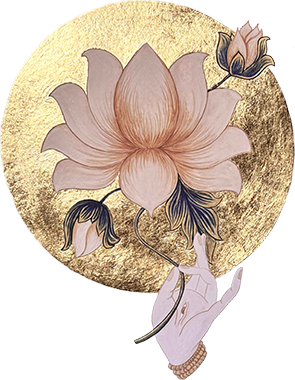
The Therapeutic Effect of Mandalas: Perspectives from Neuroscience
In today's fast-paced society, marked by information overload and constant exposure to stimuli, finding moments of calm has become a daily challenge. Stress, anxiety, and mental exhaustion are experiences shared by millions, and the search for tools that promote well-being has become a vital necessity. Among these tools, mandalas stand out not only for their aesthetic beauty but also for their real ability to influence the brain, emotions, and the environment around us.
Far from being merely a decorative object or a spiritual symbol, a mandala can act as a catalyst for calm and harmony. Its presence in a space—whether at home, in the office, or in a meditation space—generates a field of energetic balance that benefits both the observer and the environment. Modern neuroscience, combined with psychology and studies on energetic coherence, allows us to understand how and why these geometric shapes produce measurable therapeutic effects.
Neuroscience applied to mandalas
Mandalas, with their symmetrical shapes and repetitive patterns, directly impact brain function. Viewing them activates regions associated with mindfulness and emotional regulation, primarily the prefrontal lobe, responsible for concentration and planning, and the amygdala, key to stress and emotional management (Hölzel et al., 2011).
The symmetry and repetition of mandalas facilitates interhemispheric coherence, the synchronization of the right and left hemispheres. This not only improves concentration but also generates mental clarity and a state of inner calm, similar to that achieved during deep meditation or mindfulness techniques.
Neuroplasticity studies show that spending a few minutes a day contemplating a mandala strengthens the neural connections associated with attention, emotional regulation, and resilience to stress (Tang et al., 2010). Therefore, mandalas are not just art or decoration: they represent a therapeutic tool backed by science.
Beyond the Mind: Neurotransmitters and Well-being
The influence of mandalas is not limited to brain activation. Observing or interacting with these figures triggers the release of dopamine and serotonin, neurotransmitters linked to feelings of well-being, relaxation, and motivation. This chemical response explains why contemplating mandalas can induce a profound sense of serenity and enjoyment, reinforcing the meditative experience and promoting emotional recovery.
Furthermore, the mandala's harmonic patterns and colors generate an energetic resonance that affects the autonomic nervous system, helping to regulate blood pressure, heart rate, and breathing rhythm. Together, these responses make a mandala not just an attractive image, but an instrument of holistic balance.
The presence of the mandala in space: environmental therapeutic effect
Although many people associate mandalas with the practice of coloring or drawing, their mere presence in a space already produces positive effects. Modern physics considers that all matter emits a vibrational field; mandalas, with their harmonious geometry, modulate these vibrations and create an environment of coherence.
Placing a mandala in different spaces has specific benefits:
Bedroom: promotes calm, facilitates rest and improves sleep quality.
Workspace: stimulates concentration, creativity and reduces mental dispersion.
Entrance to the home or living room: acts as a symbol of energetic welcome, harmonizing interaction with visitors and balancing the energy of the place.
This ability to enhance the environment doesn't depend on artistic skill; all it takes is a visible mandala, preferably designed with harmonious proportions and balanced colors, for its effect to be felt in a subtle yet real way.
Neuroscience and colors: the influence of chromatic vibration
Color is an essential component of the mandala experience. Chromotherapy demonstrates that each hue has a distinct emotional and physiological impact (Birren, 1961):
Blue: calms, reduces anxiety and facilitates relaxation.
Green: harmony, balance and emotional healing.
Yellow: concentration and joy.
Orange: creativity and vitality.
Red: strength, energy and motivation.
Violet: introspection and spiritual connection.
Choosing mandalas with colors that align with the desired emotional state allows you to generate specific frequencies in the mind and body, creating an environment that reinforces emotional and mental stability.
Mandalas, coherence and resonance: from the heart to the brain
The HeartMath Institute has demonstrated that exposure to harmonic patterns such as mandalas generates psychophysiological coherence, a state in which heart and brain rhythms synchronize. This not only produces calm and mental clarity, but also enhances intuition and emotional resilience (McCraty et al., 2017).
In practical terms, this means that having a mandala in a space not only impacts the observer, but also modifies the energy of the environment, encouraging everything that happens in that space to develop with greater harmony and balance.
Therapeutic and educational applications
Beyond contemplation, mandalas offer multiple applications:
Guided meditation: Focusing your gaze on the center of the mandala while breathing deeply induces alpha and theta waves, associated with deep relaxation and creativity.
Art therapy: Coloring or creating mandalas strengthens attention, regulates emotions, and facilitates self-exploration. Although useful, it's not essential: the mere presence of a mandala already produces therapeutic effects.
Educational and clinical psychology: Mandalas are used in mindfulness programs, occupational therapy, and mild anxiety treatments, promoting connection with one's emotional and cognitive center.
Thus, the combination of geometry, color, and resonance makes mandalas integral tools for well-being, applicable both in therapeutic settings and in everyday life.
Science and art: a bridge between the tangible and the invisible
The mandala experience demonstrates how art, science, and spirituality can converge. Neuroscience explains the effect on the brain, modern physics describes energetic coherence, and deep psychology studies self-exploration and emotional regulation. All of this converges into a simple-to-apply phenomenon: having a mandala in view transforms perception, mood, and environment.
In this way, mandalas become a tool for complete integration, where contemplation, color vibration, and symmetry act on the mind, body, and environment, promoting well-being in a tangible and accessible way.
Conclusion: a circle that harmonizes
A mandala is not just a visual representation of balance or a decorative object: it is a proven therapeutic tool, capable of inducing calm, clarity, and psychophysiological coherence. Its simple presence in a space generates harmony in those who inhabit it, while its contemplation or creation can deepen self-exploration and emotional regulation.
By incorporating mandalas into your life, whether through observing reproductions designed for meditation or using them in everyday spaces, you invite order, serenity, and balanced energy. This accessible, science-backed practice reminds us that well-being and calm don't depend solely on external factors: they can also arise from the environment we choose and the patterns we choose to integrate into our lives.
Ultimately, a mandala is a gateway to holistic balance. It invites us to reconnect with our inner center while improving the environment around us. Each reproduction we place in our home or workspace is a reminder that harmony, clarity, and peace are within reach of our sight and mind.
Scientific and therapeutic references
Kapleau, P. – The Three Pillars of Zen
Kapleau, P. (1989). The Three Pillars of Zen . Anchor Books. (Explores meditation and mindfulness, providing context for how contemplative practices, such as observing mandalas, induce calm and concentration.)
Jung, C.G. – Man and His Symbols
Jung, C.G. (1964). Man and His Symbols . Dell. (Introduces mandalas as archetypes of the unconscious, explaining how their contemplation reflects and organizes internal processes of the psyche.)
Hölzel, BK et al. – Mindfulness practice leads to increases in regional brain gray matter density
Hölzel, BK, et al. (2011). Mindfulness practice leads to increases in regional brain gray matter density . Psychiatry Research: Neuroimaging. (Study showing brain changes associated with mindfulness, supporting the neuroscientific influence of mandalas.)
Tang, Y.Y. et al. – Short-term meditation induces white matter changes in the anterior cingulate
Tang, YY, et al. (2010). Short-term meditation induces white matter changes in the anterior cingulate . PNAS. (Showing how meditation, including contemplation of repetitive patterns such as mandalas, improves neural connectivity and emotional regulation.)
Van der Zwan, JE et al. – Effects of coloring on stress reduction and mindfulness
Van der Zwan, J.E., et al. (2015). Effects of coloring on stress reduction and mindfulness . Art Therapy. (Demonstrates the therapeutic effects of creating or coloring mandalas on stress reduction and improving mindfulness.)
McCraty, R. – Coherence: Bridging Personal, Social, and Global Health
McCraty, R., et al. (2017). Coherence: Bridging Personal, Social, and Global Health . Frontiers in Public Health. (Explains how the harmonic patterns and resonance found in mandalas induce psychophysiological coherence in the heart and brain.)
Birren, F. – Color Psychology and Color Therapy
Birren, F. (1961). Color Psychology and Color Therapy . New Age. (Studies how colors affect emotions and physiology, providing the basis for the therapeutic use of color in mandalas.)
Kaimal, G. et al. – Reduction of cortisol levels and participants' responses following art making
Kaimal, G., et al. (2016). Reduction of cortisol levels and participants' responses following art making . Art Therapy. (Investigate stress reduction by participating in artistic activities such as creating mandalas.)
Lawlor, R. – Sacred Geometry: Philosophy and Practice
Lawlor, R. (1989). Sacred Geometry: Philosophy and Practice . Thames & Hudson. (Examines sacred geometry and its influence on the perception and harmony of the environment, connecting directly with the structure of mandalas.)
HeartMath Institute – Science of the Heart
HeartMath Institute. (n.d.). Science of the Heart . heartmath.com . (Presents studies on cardiac coherence and synchronization of physiological rhythms with harmonic patterns, explaining how mandalas influence holistic well-being.)

